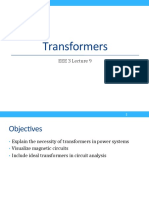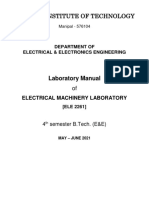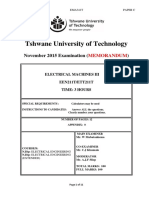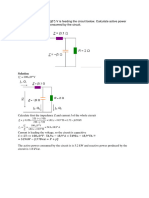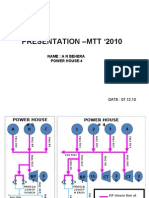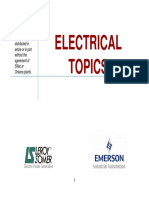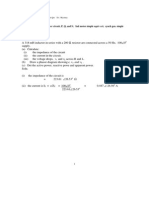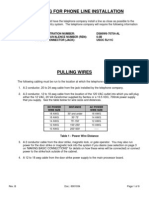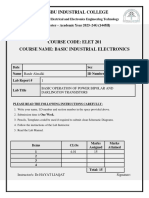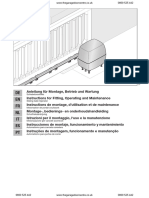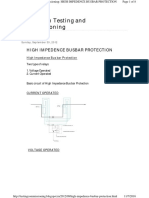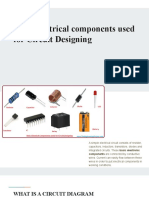1.
1 Construction of an Electrical Power Transformer and an Electricity Generator
Electrical Power Transformer:
- Core: Typically made of laminated silicon steel to minimize eddy current losses. The core
provides a path for the magnetic flux.
- Windings: There are two windings: the primary and secondary. These are coils of wire wound
around the core. The primary winding is connected to the input voltage, while the secondary
winding provides the output voltage.
- Insulation: The windings are insulated from each other and from the core to prevent short
circuits and to handle the high voltages.
-Tap Changer: An automatic tap changer adjusts the turns ratio to regulate the output voltage.
Electricity Generator:
- Stator: The stationary part of the generator that contains the windings or armature where
the electricity is generated.
- Rotor: The rotating part of the generator, which creates a rotating magnetic field. It can be
an electromagnet or a permanent magnet.
- Exciter: Provides the necessary field current to the rotor to produce a magnetic field.
- Bearings: Support the rotor and ensure it spins smoothly.
- Cooling System: Maintains the generator’s temperature to prevent overheating.
1 | Page
�1.2 Principles of Operation
Electrical Power Transformer:
- Electromagnetic Induction: A transformer operates on the principle of electromagnetic
induction. An alternating current (AC) in the primary winding creates a magnetic field, which
induces a voltage in the secondary winding.
- Turns Ratio: The voltage ratio between the primary and secondary windings is proportional to
the ratio of the number of turns in each winding. This relationship is given by:
{V 1 } { N 1 }
=
{V 2 } { N 2 }
Electricity Generator:
- Electromagnetic Induction: A generator works on the principle of electromagnetic induction.
The rotation of the rotor within the stator generates a changing magnetic flux, which induces
an electromotive force (EMF) in the stator windings.
Faraday’s Law: The induced EMF in the stator is proportional to the rate of change of magnetic
flux.
### 1.3 Circuit Diagram
The circuit diagram of the electrical system can be visualized as follows:
- Transformer: Primary side connected to 2400 V supply.
- Transmission Line: Connected to the secondary side of the transformer, having impedance
(0.5+ j 0.01ω ).
- Load: Consists of three 1-phase linear loads in parallel, with specified power and current
ratings.
1.4 Power Factor Correction Calculations
1. Calculate the Total Load Power and Current:
2 | Page
� Load powers:
- Load 1 :20 kW , 112 A
- Load 2 :28 kW , 150 A
- Load 3: 12 kW , 75 A
Total Load Power (P)=20 kW +28 kW +12 kW =60 kW
Total Load Current (I {load } ):
Given that all loads are connected in parallel:
- (I {total }=I 1 + I 2+ I 3=112 A +150 A +75 A=337 A)
Total Load Apparent Power (S) can be computed using:
S=V × I {total}=230 V ×337 ¿=77,510 VA=77.51 kVA
2. Determine the Existing Power Factor:
The total power factor (pf) is given as 0.98 lagging. The reactive power (Q) can be
determined from:
Power Factor=cos θ
Using the power factor and real power:
{ { Real Power } }{ { Apparent Power } }
Power Factor= ⇒=60 kW
real Power
{ 60 }
Apparent Power= ≈ 61.22 kVA
{ 0.98 }
Reactive Power ( Q )= √ { S −P }
2 2
3 | Page
� For the original power factor correction, use the formula to compute the needed kVAR to
adjust:
Q{ new }=Q{ old }−{Needed Reactive Power }
3. Compute the Required Capacitor kVAR:
√
Q { needed }=S × {1−( { pf } )
2
}
Q{ needed }=77.51× √ {1−( 0.98 ) } ≈77.51 × 0.207=16.05 kVAR
2
With the power factor correction:
New Reactive Power=Q {old }−Q {needed }
The capacitor required is approximately 16.05 kVAR.
1.7 Transformer Primary and Secondary Voltages and Turn Ratios
Before Power Factor Correction:
- Primary Voltage: 2400 V
- Secondary Voltage: 230 V
-Turns Ratio:
{V { primary } } {2400 }
Turns Ratio= = ≈ 10.43
{V {secondary } } {230 }
]
4 | Page
�After Power Factor Correction:
the power factor correction process improves the power factor, reducing line losses and
improving transmission efficiency. Capacitors of approximately 16.05 kVAR are needed to
achieve the desired power factor of 0.98 lagging.
Task 02
Calculate the Load Impedance
Given Data:
- Load Voltage, (V L=228V )
- Load Current, (I L =296 A)
- Power Factor before correction: 0.78 inductive
Calculate the Magnitude of the Load Impedance:
The magnitude of the load impedance¿ is calculated as:
{|V L|} = { 228 V } ≈ 0.771 Ω
|Z L|=
{|I L|} { 296 A }
Determine the Phase Angle of the Load Impedance:
The power factor angle ( ϕ ) is given by:
{− 1 }
[ϕ=co s ( 0.78 ) ≈ 38.2∘ ]
As the power factor is inductive, the impedance angle is positive:
∘
[ Angle (Z L )=38.2 ]
In rectangular form, the load impedance (Z L ) is:
[Z L=0.771 ( cos 38.2∘+ jsin 38.2∘ ) ≈ 0.771 ( 0.788+ j 0.615 ) ≈ 0.606+ j0.473 Ω]
5 | Page
�Step 2: Calculate the Thevenin Equivalent for the Generators
Given Data:
- Generator Open Circuit Voltage (V { oc }=232V )
- Internal Impedance ( Z {gen }=0.06+ j0.02 Ω )
- Line Impedance Z {line }=0.08+ j 0.01 Ω¿
Thevenin Equivalent Impedance:
The total Thevenin impedance (Z {th }) is the sum of the generator's internal impedance and the
line impedance:
Z {th }=Z {gen }+ Z {line }=(0.06+ j 0.02)+(0.08+ j0.01)=0.14 + j 0.03 {Ω}¿
Thevenin Equivalent Voltage:
The Thevenin equivalent voltage is the same as the open circuit voltage:
[V {th }=232 V ]
Step 3: Check Generator Load
Determine the Total Load Current:
Combine the load impedance ( Z L =0.606+ j0.473 Ω) with the Thevenin impedance:
[Z {total }=Z {th }+ Z L =(0.14+ j 0.03)+(0.606+ j 0.473)=0.746+ j0.503 Ω]
Calculate the magnitude of ( Z {total } ):
[¿ Z {total }∨¿ √ { 0.7462 } +0.503 2 ≈ 0.893 Ω]
The load current (I {load } ) is:
{ 232 }
[|I {load |} = ≈ 259.5 A]
{ 0.893 }
6 | Page
�Calculate Current Per Generator:
Since the generators are in parallel, each one supplies:
{259.5 }
[ =129.75 A ]
{2 }
Check Generator Ratings:
Each generator is rated for 32 kVA. The current rating for each generator is:
[ I {rated }= {32,000 VA } } ≈ 137.9 A ¿
{ 232V }
Comparison:
Each generator is supplying about 129.75 A, which is below its rated current of 137.9 A.
Conclusion:
- Load Impedance: (Z L =0.606+ j0.473 Ω})
- Thevenin Equivalent Impedance:(Z {th }=0.14 + j 0.03 Ω)
- Total Load Current: Approximately 259.5 A, or 129.75 A per generator
- Generator Current Rating: 137.9 A per generator
The generators are operating within their rated current capacity and are thus not overloaded.
7 | Page
�Task 03
3.1 Equation of the Inverter Output Voltage After Harmonics Filtering
Given waveform:
{ 1020 }
v ( t )= ¿
{π}
Harmonic filtering percentages
{1}
- 5th harmonic: 94% of ( sin (500 π t))
{5}
{1}
- 7th harmonic: 94% of ( sin (700 π t))
{7}
{1 }
- 11th harmonic: 96% of sin (1100 π t)
{ 11}
{1}
- 13th harmonic: 96% of ( sin (1300 π t))
{ 13 }
{1}
- 17th harmonic: 98% of ( sin (1700 π t))
{ 17 }
{1}
- 19th harmonic: 98% of ( sin(1900 π t))
{ 19 }
- 25th and above: 100% (no attenuation)
After filtering, the waveform is:
{1020 } {1 } {1} {1 } {1}
v f (t )= (sin ( 100 π t ) +0.94 ⋅ sin (500 π t )+ 0.94 ⋅ sin ( 700 π t ) +0.96 ⋅ sin ( 1100 π t )+ 0.96 ⋅ sin ( 1300 π t
{π } {5} {7 } { 11} {13 }
8 | Page



